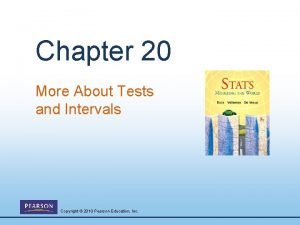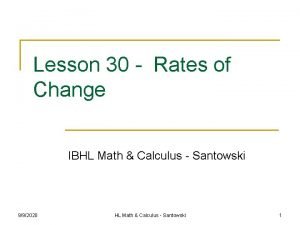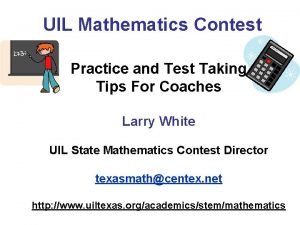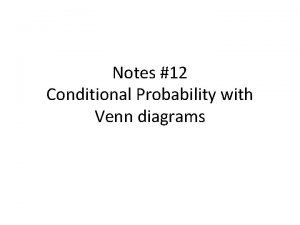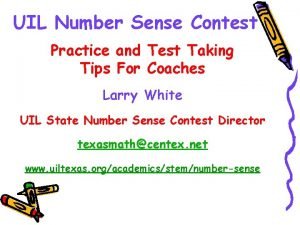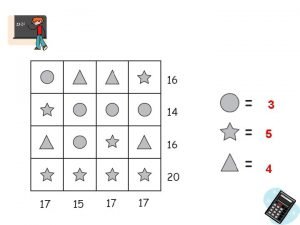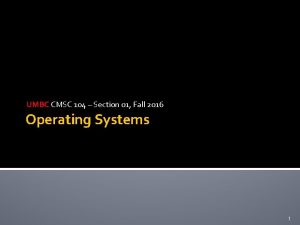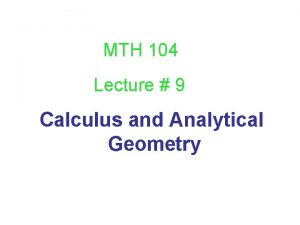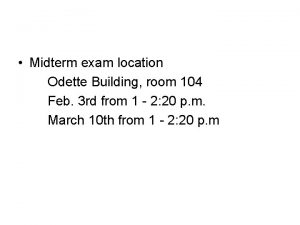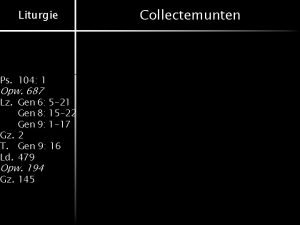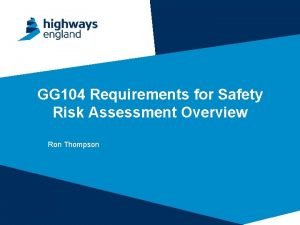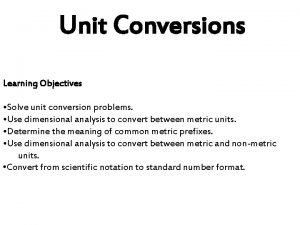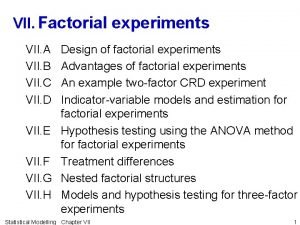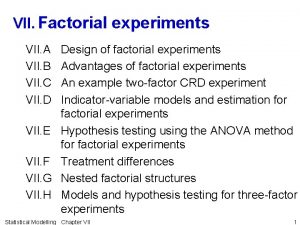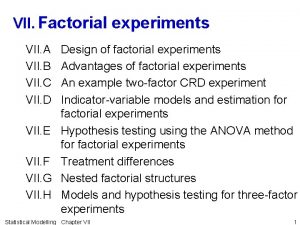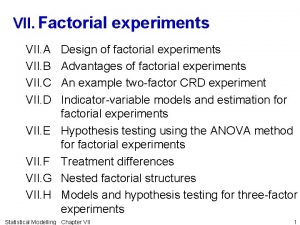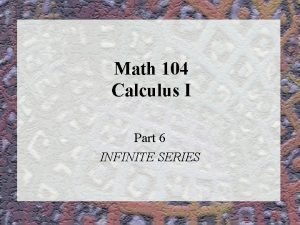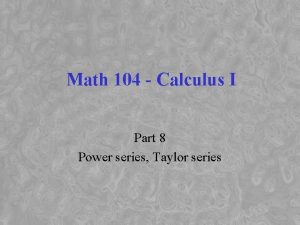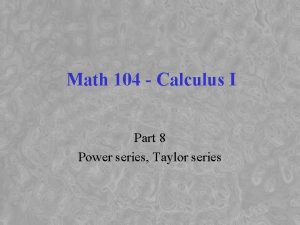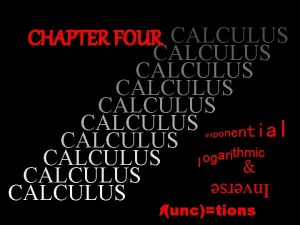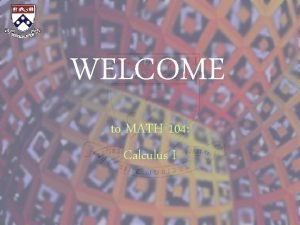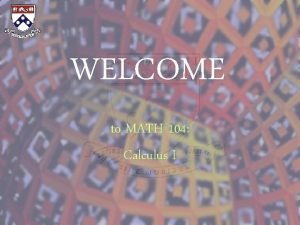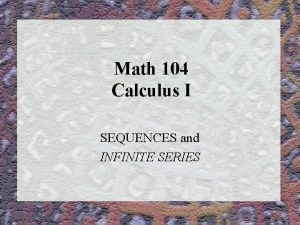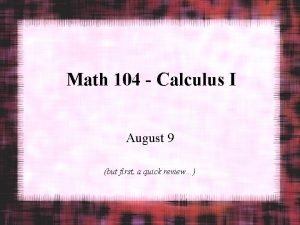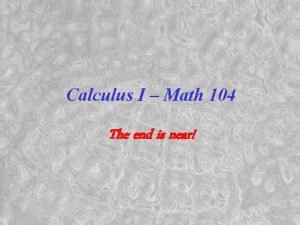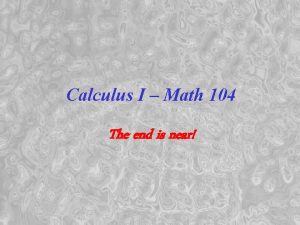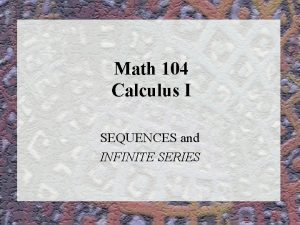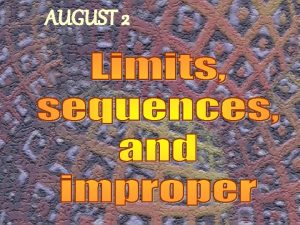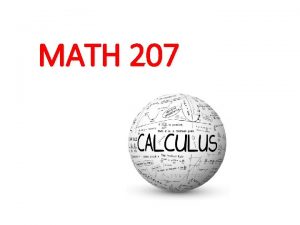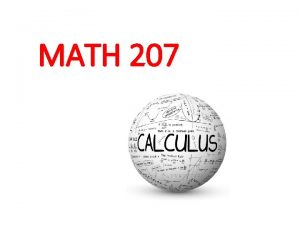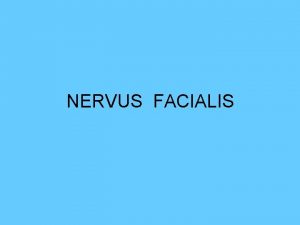Math 104 Calculus I Part VII More tests




































- Slides: 36

Math 104 - Calculus I Part VII: More tests for convergence; Power series

Convergence Tests. . . 1. The integral test 2. The comparison test 3. The ratio test 4. The limit comparison test (sometimes called the ratio comparison test) 5. The root test

The ratio test is a specific form of the comparison test, where the comparison series is a geometric series. We begin with the observation that for geometric series, the ratio of consecutive terms is a constant (we called it r earlier).

Ratio test (cont. ) • For other series, even if the ratio of consecutive terms is not constant, it might have a limit as n goes to infinity. If this is the case, and the limit is not equal to 1, then the series converges or diverges according to whether the geometric series with the same ratio does. In other words:

The ratio test:

Example:

Another example: For , the ratio is 1 and the ratio test is inconclusive. Of course, the integral test applies to these p-series.

Question A) Converge B) Diverge

Question A) Converge B) Diverge

Root test • The last test for series with positive terms that we have to worry about is the root test. This is another comparison with the geometric series. It's like the ratio test, except that it begins with the observation that for geometric series, the nth root of the nth term approaches the ratio r as n goes to infinity (because the nth term is arn and so the nth root of the nth term is a 1/nr-- which approaches r since the nth root of any positive number approaches 1 as n goes to infinity.

The root test says. . .

Example

Question A) Converge B) Diverge

Series whose terms are not all positive • Now that we have series of positive terms under control, we turn to series whose terms can change sign. • Since subtraction tends to provide cancellation which should "help" the series converge, we begin with the following observation: • A series with + and - signs will definitely converge if the corresponding series obtained by replacing all the - signs by + signs converges.

Absolutely convergent series A series whose series of absolute values converges, which is itself then convergent, is called an absolutely convergent series.

Examples. . . Series that are convergent although their series of absolute values diverge (convergent but not absolutely convergent) are called conditionally convergent.

Alternating series A special case of series whose terms are of both signs that arises surprisingly often is that of alternating series. These are series whose terms alternate in sign. There is a surprisingly simple convergence test that works for many of these:

Alternating series test:

Example: The alternating harmonic series clearly satisfies the conditions of the test and is therefore convergent. The error estimate tells us that the sum is less than the limit, and within 1/5. Just to practice using the jargon, the alternating harmonic series, being convergent but not absolutely convergent, is an example of a conditionally convergent series.

Classify each of the following. . . A) Absolutely convergent B) Conditionally convergent C) Divergent

Classify each of the following. . . A) Absolutely convergent B) Conditionally convergent C) Divergent

Classify each of the following. . . A) Absolutely convergent B) Conditionally convergent C) Divergent

Power series Last week's project was to try and sum series using your calculator or computer. The answers correct to ten decimal places are: Sum((-1)^n/(2*n+1), n=0. . infinity) = evalf(sum((-1)^n/(2*n+1), n=0. . infinity)); Sum(1/factorial(n), n=0. . infinity)=evalf(sum(1/factorial(n), n=0. . infinity) );

Power series (cont. ) Sum(1/n^2, n=1. . infinity)=evalf(sum(1/n^2, n=1. . infinity)); Sum((-1)^(n+1)/n, n=1. . infinity)=evalf(sum((-1)^ (n+1)/n, n=1. . infinity)); We can recognize these numbers as

Two directions: 1. Given a number, come up with a series that has the number as its sum, so we can use it to get approximations. 2. Develop an extensive vocabulary of "known" series, so we can recognize "familiar" series more often.

Geometric series revisited

r as a variable Changing our point of view for a minute (or a week, or a lifetime), let's think of r as a variable. We change its name to x to emphasize the point: So the series defines a function (at least for certain values of x).

Watch out. . . We can identify the geometric series when we see it, we can calculate the function it represents and go back and forth between function values and specific series. We must be careful, though, to avoid substituting values of x that are not allowed, lest we get nonsensical statements like

Power series If you look at the geometric series as a function, it looks rather like a polynomial, but of infinite degree. Polynomials are important in mathematics for many reasons among which are: 1. Simplicity -- they are easy to express, to add, subtract, multiply, and occasionally divide 2. Closure -- they stay polynomials when they are added, subtracted and multiplied. 3. Calculus -- they stay polynomials when they are differentiated or integrated

Infinite polynomials So, we'll think of power series as "infinite polynomials", and write

Three (or 4) questions arise. . . 1. Given a function (other than ), can it be expressed as a power series? If so, how? 2. For what values of x is a power series representation valid? (This is a two part question -- if we start with a function f(x) and form "its" power series, then (a) For which values of x does the series converge? (b) For which values of x does the series converge to f(x) ? [There's also the question of "how fast". ]

continued 3. Given a series, can we tell what function it came from? 4. What is all this good for? As it turns out, the questions in order of difficulty, are 1, 2(a), 2(b) and 3. So we start with question 1:

The power series of a function of f(x) Suppose the function f(x) has the power series Q. How can we calculate the coefficients ai knowledge of f(x)? from a A. One at a time -- differentiate and plug in x=0!

Take note. . .

Continuing in this way. . .

Example Suppose we know, for the function f, that f(0)=1 and f ' = f. Then f '' = f ', f ''' = f '' etc. . . So f '(0) = f '''(0) =. . . = 1. From the properties of f we know on the one hand that So we get that. . .
 More more more i want more more more more we praise you
More more more i want more more more more we praise you More more more i want more more more more we praise you
More more more i want more more more more we praise you Ace different tests help iq still
Ace different tests help iq still Chapter 20 more about tests and intervals
Chapter 20 more about tests and intervals Flipped math calculus
Flipped math calculus Math calculus
Math calculus Uil number sense scoring
Uil number sense scoring P(a given b) formula
P(a given b) formula Number sense competition
Number sense competition Tmsca science practice tests
Tmsca science practice tests Aimsweb plus
Aimsweb plus The more you take the more you leave behind
The more you take the more you leave behind The more you study the more you learn
The more you study the more you learn Aspire not to have more but to be more
Aspire not to have more but to be more Law of inertia definition
Law of inertia definition Knowing more remembering more
Knowing more remembering more The more i give to thee the more i have
The more i give to thee the more i have More choices more chances
More choices more chances Human history becomes more and more a race
Human history becomes more and more a race Get more math
Get more math Math is more than just numbers
Math is more than just numbers Apple notes
Apple notes Programa presupuestal 104
Programa presupuestal 104 Lativ104
Lativ104 Calculus with analytic geometry examples
Calculus with analytic geometry examples Odette building 104
Odette building 104 Who is this
Who is this Opw 687
Opw 687 Gg-104
Gg-104 Cct 104
Cct 104 Aphorism 83 to 104
Aphorism 83 to 104 Cao 104
Cao 104 Cao 104
Cao 104 Baby i'm foolish maybe i'm blind
Baby i'm foolish maybe i'm blind Csci 104 usc syllabus
Csci 104 usc syllabus How to solve conversion problems
How to solve conversion problems I 102 104
I 102 104



